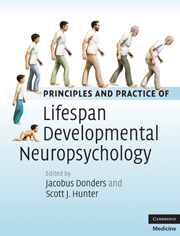Book contents
- Frontmatter
- Contents
- Contact information for authors
- Biography for Jacobus Donders and Scott J. Hunter
- Introduction
- Section I Theory and models
- 1 A lifespan review of developmental neuroanatomy
- 2a Developmental models in pediatric neuropsychology
- 2b Models of developmental neuropsychology: adult and geriatric
- 3 Multicultural considerations in lifespan neuropsychological assessment
- 4 Structural and functional neuroimaging throughout the lifespan
- Section II Disorders
- Index
- Plate section
- References
2a - Developmental models in pediatric neuropsychology
from Section I - Theory and models
Published online by Cambridge University Press: 07 May 2010
- Frontmatter
- Contents
- Contact information for authors
- Biography for Jacobus Donders and Scott J. Hunter
- Introduction
- Section I Theory and models
- 1 A lifespan review of developmental neuroanatomy
- 2a Developmental models in pediatric neuropsychology
- 2b Models of developmental neuropsychology: adult and geriatric
- 3 Multicultural considerations in lifespan neuropsychological assessment
- 4 Structural and functional neuroimaging throughout the lifespan
- Section II Disorders
- Index
- Plate section
- References
Summary
“A single good model is worth a thousand empirical studies”
James Heckman (Nobel Prize, Economics, 2000) quoted by David Kirp“Good models are like good tools: they do a certain job reasonably well … simple models that work well for a wide variety of jobs are especially valuable … (they yield) islands of conceptual clarity in the midst of otherwise mind-numbing complexity and diversity”
Richerson and BoydIntroduction
On what grounds does a hard-nosed number-crunching economist make such a claim? What does he mean? What are the implications for the elaboration of the knowledge base? For clinical practice?
A model is a tool for thinking, for organizing a body of data into a theoretically coherent construct whose validity can be tested. Thinking in both research and clinical arenas is based on a constant interaction between models and evidence. The challenge of empirical data (evidence) is that at any one point there may be much to make sense of. Data are not always internally consistent; and, until established by multiple replications across data sets, evidence is constantly subject to discussion, argument, and change. Models may not be subject to as rapid change as the evidence base. They cannot, nonetheless, be static: as evidence accumulates, models must be scrutinized and reformulated.
There are two major sources of change in science.
- Type
- Chapter
- Information
- Publisher: Cambridge University PressPrint publication year: 2010
References
- 8
- Cited by

